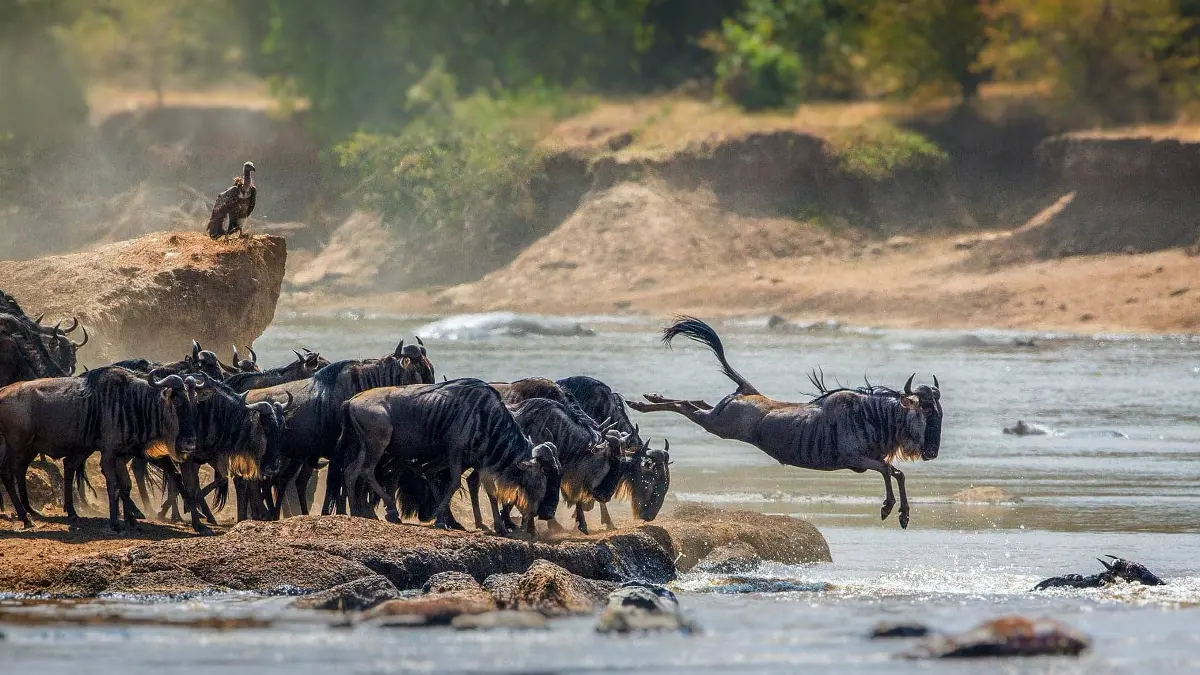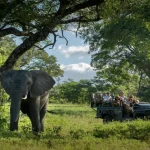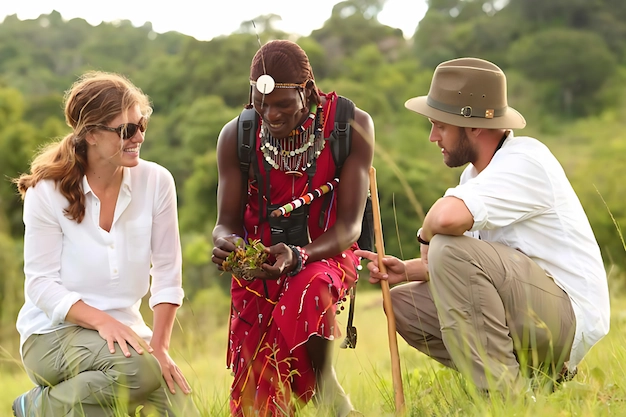The Great Migration in Serengeti National Park, Tanzania, is an unforgettable experience for anyone who loves nature and wildlife. Located in northern Tanzania, Serengeti National Park is one of the most famous parks in Africa. It is known for its vast savannahs and diverse wildlife, most notably.
The Great Migration occurs yearly. Millions of wildebeests, zebras, and gazelles travel across the Serengeti for fresh grazing lands. This incredible journey is considered one of the most impressive wildlife spectacles and attracts visitors worldwide.
During the Great Migration Safari in Serengeti, visitors can witness this incredible event up close as herds of animals cross rivers filled with crocodiles and hippos and brave the dangers of predators lurking around every corner.
In addition to the Great Migration in Serengeti, Serengeti National Park is also home to many wildlife, including lions, leopards, elephants, and giraffes. Visitors can take guided tours inside the park to go close to the river’s bank, where the cross is taking place under the supervision of an armed safari ranger, and enjoy the breathtaking scenery and wildlife sightings.
Overall, the Great Migration Safari in Serengeti National Park is a once-in-a-lifetime experience that should be on every nature lover’s bucket list. The park’s natural beauty and incredible wildlife make it a must-visit destination for anyone who wants to experience the best of Africa’s wilderness in 2025 or 2026.
Why Wildebeest migrate in Serengeti?
Wildebeest migrate to Serengeti for several reasons. One of the main reasons is to seek better grazing land and freshwater sources. As the seasons change, the wildebeest herd follows the rains in search of new grass, which provides the nutrients they need to survive. During the dry season, the wildebeest moves towards the Mara River in search of water and green pastures.
The migration also helps the wildebeest avoid predators, such as lions and hyenas, which are less likely to attack large herds. Additionally, migration is an integral part of the wildebeest’s reproductive cycle, as it allows males to mate with females from other herds, increasing genetic diversity. Overall, the wildebeest migration in Serengeti is a natural phenomenon essential to this iconic species’ survival.
The Great Migration is a natural phenomenon in East Africa Safari tours, mainly in Tanzania and Kenya, where millions of wildebeest, zebras, and gazelles move in search of food and water. The migration is a continuous cycle dependent on seasonal changes, with the herds moving from the Serengeti National Park in Tanzania to the Maasai Mara National Reserve in Kenya and then back again. Migration is also a crucial part of the ecosystem, as it helps to maintain a balance between the predators and prey. It is a breathtaking sight to witness and attracts thousands of tourists annually.
Is it worth to see the Wildebeest River Crossing in Serengeti?
Yes, the journey of the wildebeests and other animals begins in the southern Serengeti in Tanzania, where they give birth to their young between January and February. The calving season is a time of plenty for predators such as lions, hyenas, and leopards who prey on newborn animals. Once the young have grown strong enough, the wildebeests begin their journey northwards in search of greener pastures.
As the rains peter out in the south Serengeti, wildebeests start migrating northwards towards the Masai Mara in Kenya via the Central Serengeti. They travel in large herds, trampling over the vast plains of the Serengeti and crossing rivers such as the Mara and Grumeti, home to some of the world’s largest crocodiles. Many wildebeests perish in the crossing as they become prey to the crocodiles, while others succumb to the swift currents of the rivers.
Wildebeests arrive in the Masai Mara in July and August and stay until October. The Mara is rich in grass, and the animals can graze to their hearts’ content. This is also when the wildebeest’s mate and the cycle begins anew.
“The Serengeti wildebeest migration is not only a tourist spectacle; it is much more than that.” it is also an essential part of the ecosystem. The movement of the animals helps maintain the grasslands, and the predators help control the herbivores’ population. The migration is also a reminder of the beauty and power of nature and a testament to the resilience of the animals that call the Serengeti home.
Is it possible to see Wildebeest Crossing in Serengeti in November?
When planning the great migration in Serengeti safari, it’s natural to want to witness this incredible event. However, it’s important to remember that nature has no guarantees. Timing is everything, and the exact timing of the migration can be unpredictable. Therefore, it’s crucial to understand that risk is always involved when planning your visit to the Serengeti, especially if you don’t follow the expert’s advice. The Great Serengeti Migration is a year-round cycle in Tanzania and Kenya. Here’s a breakdown of the migration cycle month by month:
January to March:
During these months, the wildebeest herd can be found in the southern Serengeti – Ndutu area, where they give birth to their young. This is known as the calving season, and it’s a time of plenty for predators like lions, hyenas, and cheetahs.
April to May:
As the rains fall, the wildebeest herd moves northwards towards the central Serengeti and Western Serengeti via the private concession of Grumeti. This is plenty of time for the wildebeest, as the grass is lush and green.
June to July:
This is the time of the famous river crossings, as the wildebeest herd attempts to cross the Grumeti and Mara rivers. These crossings are treacherous, and many wildebeest are killed by crocodiles or drowning in the rushing waters.
August to October:
The wildebeest herd has now reached Kenya’s northern Serengeti and Masai Mara. This is the dry season, and the grass is scarce. The wildebeest must move constantly in search of food and water, and many fall prey to predators.
November to December:
As the short rains begin to fall, the wildebeest herd starts to move southwards once again, towards the southern Serengeti, to the area known as the Ndutu Region. The cycle begins anew as the wildebeest gives birth to their young, and the predators await their next hunting opportunity.
When to visit Serengeti to See River Crossing 2025
If you’re planning to witness the great wildebeest migration in the Serengeti, you should plan your visit accordingly. The best time to see the migration is from late June to October when the wildebeest gather in the Serengeti’s northern region, known as the Mara River. During this time, you can see thousands of wildebeest crossing the river in search of greener pastures.
However, it’s essential to remember that “The exact timing of the migration can vary from year to year, depending on various factors such as weather conditions, availability of food, and other environmental factors,” including rainfall.
We advise consulting with a travel specialist from East Africa Safari Guides for the most accurate information regarding the location of the wildebeests and recommended accommodations.
THE BEST AFRICA SAFARI EXPERIENCE 2025 IS HERE
Overall, visiting the Serengeti during the migration season is an unforgettable experience for any wildlife enthusiast or nature lover. Don’t miss this opportunity to witness the most dramatic movie on Earth with your family or significant other.








